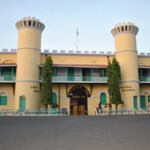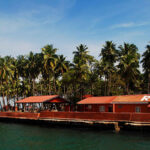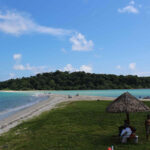Cellular Jail in Andaman and Nicobar Islands
Cellular Jail in Andaman and Nicobar Islands, India, remains as a dim memory of the British rule in India. This most feared and tiresome provincial jail arranged in the remote archipelago was utilized by the British especially to banish Indian political prisoners. Segregated from the terrain, this jail, also known as Kala Pani (where Kala implies death or time and Pani implies water in Sanskrit) saw the most brutal tortures on prisoners. India’s battle for freedom saw up and coming opportunity contenders like Batukeshwar Dutt and Veer Savarkar being kept in this prison. The jail is presently open to open survey as a National Memorial, and its exhibition hall gives one a look at long periods of India’s battle for opportunity.
Establishment and History of the Jail
Despite the fact that the Andaman Islands were utilized by the British as a jail not long after the Indian Rebellion of 1857 (the Sepoy Mutiny), the establishment of this prison was laid in 1896. The consequence of what was viewed as India’s First War of Independence anyway went for the British who stifled the revolt executing numerous dissidents and exchanging the rest to Andaman for lifetime banish. The renegades in hundreds were sent to the island where they stayed under the care of corrections officer David Barry and military specialist Major James Pattison Walker. 238 prisonors who endeavored to get away from the correctional facility in March 1868 were gotten in April of whom 87 were hanged. An ever increasing number of freedom fighters who raised voice against the british rule were sentenced and transported here from British-controlled India and Burma.
The prisoners feared the waters of Andamans and being segregated from the territory there were no chance to get out for them to get away. The island turned into an adept place for the British to rebuff the opportunity contenders. The prisoners were tied and made to work in developing structures, jails and harbor offices in quest for colonizing Andaman for the British. With the upsurge of Indian autonomy development in the late nineteenth century, a few prisoners were sent to Andaman that required for a higher security jail. Sir Charles James Lyall, home secretary in the administration of the British Raj and A. S. Lethbridge, a specialist in the British organization proposed presentation of a “punitive stage” in the transportation sentence given to a detainee with the goal that the detainee confront unforgiving treatment for a specific period after expulsion to the Andamans. This prompted development of the Cellular Jail, work of which initiated in 1896 and completed in 1906.
In 1942 the Japanese overwhelmed the British in the Andaman Islands driving them out of the islands. Netaji Subhas Chandra Bose visited Andaman amid this time. Following the second’s end ‘World War’, in 1945 the British recaptured control of the islands.
Outline of the Cellular Jail
The working of the Cellular Jail initially had seven straight wings each associated with a pinnacle in the center giving the entire development a look of something like a bike wheel with each wing joined with the inside pinnacle like a discussed the wheel. This outline depended on English rationalist and social scholar Jeremy Bentham’s idea of the Panopticon. Puce shaded blocks were conveyed from Burma to develop the building. The pinnacle in the middle that framed the purpose of crossing point of all the seven wings filled in as a watch point for the watchmen of the correctional facility to keep vigil on prisoners. It had an expansive ringer for raising alert. The wings, every one of which had three stories, were built in such way that the front of one wing faces the back of another so one detainee in a wing can’t see or speak with another prisoner in any of the nearby wings. Indeed, even the cells in a wing were in succession with the goal that prisoners in a similar wing additionally can’t impart or see one another. Every phone housed just a single prisoner guaranteeing negligible shot of correspondence among prisoners in this way disconnecting them from one another. This component of isolation in singular cells earned the correctional facility its name, “Cell”. There were an aggregate of 693 cells, each estimating 4.5 m by 2.7 m with a ventilator situated at a stature of 3 m. There were no residences in the prison.
Life in the Jail
Outstanding flexibility warriors bound in the correctional facility included Batukeshwar Dutt, Diwan Singh Kalepani, Fazl-e-Haq Khairabadi, and the Savarkar siblings – Babarao Savarkar and Vinayak Damodar Savarkar among others. Being in isolation the Savarkar siblings were ignorant of one another’s quality in a similar prison for a long time. Numerous flexibility contenders in the prison experienced barbaric and unbelievable torments, the simple idea of which cuts chills down the spines. The correctional facility drew consideration when its prisoners watched hunger strikes in the mid 1930s. Bhagat Singh’s partner in the flexibility development, Mahavir Singh went on a yearning strike in dissent of such coldblooded treatment however kicked the bucket when experts endeavored to encourage him drain coercively which went to his lungs. His body was tossed into the sea. In 1937-38 following intercession by Mahatma Gandhi and Rabindranath Tagore the administration settled on repatriating the flexibility contenders.
Visiting the Cellular Jail
Throughout the years, the building was damaged and just three wings and the pinnacle remains. In 1969 it was declared a National Memorial. Tourists from India and around the globe visit the island which is overwhelmingly popular for the Cellular Jail separated from its picturesque magnificence. The National Memorial houses a few displays including Freedom Fighters Photo and Exhibition Gallery in the ground floor and an Art display and Netaji Gallery on the primary floor among others.
Light and Sound Show
In the memory of the overcome saints, the Cellular Jail specialists sort out a light and sound show on each Tuesdays, Thursdays, Saturdays and Sundays. The Hindi show timings are 6:00 PM and 7:15 PM, while there is just a single English show at 7:15 PM. The light and sound show not just changes the phone imprison into a wonderful phase of a live execution yet additionally portrays the tragic history of freedom development alongside the lives of the prisoners in the prison amid the British time.




















